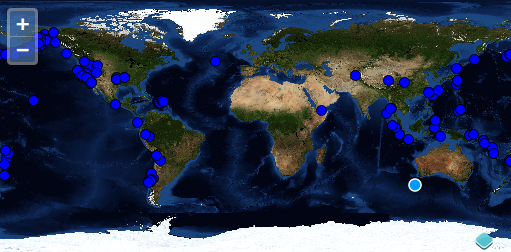Neue Features kann man mittels einer ol.interaction.Draw zeichnen. Eine solche Draw-Interaktion benötigt beim initialisieren eine Vektor-source und einen Geometrietyp.
Übungen
Wir beginnen mit dem unten aufgeführten Beispiel. Öffnen Sie die Datei map.html im Texteditor und stellen Sie sicher, dass der Inhalt etwa wie folgt aussieht.
<!doctype html>
<html lang="en">
<head>
<link rel="stylesheet" href="ol3/ol.css" type="text/css">
<style>
#map {
height: 256px;
width: 512px;
}
</style>
<script src="ol3/ol.js" type="text/javascript"></script>
<title>OpenLayers 3 example</title>
</head>
<body>
<h1>My Map</h1>
<div id="map"></div>
<script type="text/javascript">
var source = new ol.source.GeoJSON({
url: 'data/layers/7day-M2.5.json'
});
var draw = new ol.interaction.Draw({
source: source,
type: 'Point'
});
var map = new ol.Map({
interactions: ol.interaction.defaults().extend([draw]),
target: 'map',
layers: [
new ol.layer.Tile({
title: "Global Imagery",
source: new ol.source.TileWMS({
url: 'http://maps.opengeo.org/geowebcache/service/wms',
params: {LAYERS: 'bluemarble', VERSION: '1.1.1'}
})
}),
new ol.layer.Vector({
title: 'Earthquakes',
source: source,
style: new ol.style.Style({
image: new ol.style.Circle({
radius: 5,
fill: new ol.style.Fill({
color: '#0000FF'
}),
stroke: new ol.style.Stroke({
color: '#000000'
})
})
})
})
],
view: new ol.View({
projection: 'EPSG:4326',
center: [0, 0],
zoom: 1
})
});
</script>
</body>
</html>
Speichern Sie Ihre Änderungen und laden Sie die Seite im Browser neu: http://localhost/ol3-ws/map.html
Klicken Sie mit der linken Maustaste auf die Karte, um neue Features hinzuzufügen.

Featureerzeugung mittels einer Draw-Interaktion.
Zusatzaufgabe